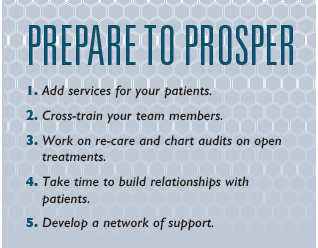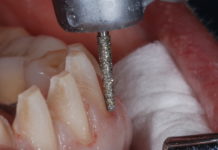
Disaster-Proof Your Dental Practice.
I have been practicing dentistry in New Orleans, LA, for nearly 30 years, and I still enjoy the work. Initially, I was drawn to dentistry because it is a profession that combines art and science. The goal is to help patients achieve and maintain their dental health, and in the process they look and feel better about themselves.
Throughout the years, the dental field has given me opportunities for personal growth and development. I have learned how to build relationships and have come to see the importance of connecting and interacting with patients in a positive way. Like any other business, dentistry has its ups and downs. Uncontrollable external factors can cause upturns or downturns in a dental practice. I have learned to develop emotional intelligence with regards to those fluctuations, because team members and patients look to the dentist to be a leader and to provide guidance and direction.
A Catastrophic Storm
In August 2005, Hurricane Katrina struck the Gulf Coast of the United States, arriving as a category 3 storm with sustained winds exceeding 125 miles per hour. On August 29, Katrina hit New Orleans. When pressure on the city’s levees caused them to fail, 80 percent of the city was flooded, and the flood waters lingered for weeks after the storm. The mayor ordered a mandatory evacuation the day before the storm hit, and those of us who had access to a car left the city. Fortunately, my family and my dental team were able to retreat to safety.

At the time, I was practicing dentistry in a retail space. After the storm subsided, the building was deemed a total loss due to flooding and roof damage. Like many others, the building owner decided to collect on the insurance and sell the property, leaving me without a place to practice dentistry. A number of dentists decided to leave the city of New Orleans because of devastation caused by Hurricane Katrina, and I considered leaving too. I knew that if I decided to stay, I wanted to rebuild in a certain area of town, but that would take some time.
After three weeks of worrying about my options, I discovered that I had “practice interruption insurance,” an insurance rider that pays your salary, overhead, and team members’ salaries for up to a year (based on the previous year’s numbers). When I found out about the insurance, it took a lot of stress off my shoulders. My first thought was, “I guess I can just sit around for a year and collect my salary. That’s not too bad!” It only took a couple of weeks for me to realize that I needed and wanted to go back to work.
Since I couldn’t reopen my practice in our previous location, I reviewed my options and ultimately decided to purchase an existing practice from a dentist who was leaving New Orleans. It gave me a place to start practicing immediately, and I also inherited new patients from that practice, which helped offset the ones I was losing because so many people were leaving the area. Although I didn’t know it at the time, by buying his dental practice, I ultimately ended up doubling my own.
The practice wasn’t exactly where I wanted to be in terms of location, but I stayed there for two and a half years while we procured a new location and built it out. Today, my new practice location is only about three miles away from the original one that was destroyed by Katrina.
Starting Over
After four and a half months, my practice was back in business on January 15, 2006. During the interim, I did some work out of different dental offices—maintaining things and seeing emergency cases—but I wasn’t really doing significant dentistry. After I returned to an office regularly, things started moving forward.
One of the main motivations for me to get back to work was that I realized how much I value work, and I wanted to be productive again. I also soon realized that my patients would find another dentist if I didn’t make myself available. For about five years after Katrina, I remember saying, “life will get back to normal, but it will never be the same.” In New Orleans, we always refer to things as pre- or post-Katrina. It was a defining moment for everyone. I would never want to go through it again, but with hindsight, I ended up better off for it.
Most dentists don’t have to go through such a dramatic upheaval. But everyone experiences highs and lows. Because my work was taken away from me, I learned to never take it for granted. I value going to work every day. I learned that my profession is a big part of who I am as a person. Katrina changed my perspective on work and dentistry in general. A lot of people work their whole careers looking forward to retirement. They take very little time off, and they think that retirement is the ultimate goal. But sometimes they retire and realize that there is an inherent value to work that they miss. I definitely look forward to retirement, but I try to enjoy the present and my ability to work and be productive every day.
Stay the Course
Life can be unpredictable and it can take you by surprise. I’ve learned several key principles that have helped me survive the ups and downs of the past 30 years—and even thrive after something as dramatic as Katrina. I’ve learned to not be too proud or braggadocious when times are good. I try to stay even-keeled throughout good times and bad. It’s important for the leader of the team to have emotional intelligence and stay steady no matter what circumstances arise.
Debt and overhead can make life especially difficult during slow times. In my practice, when things have been slow, we have been much more cautious with our purchases. If I’m going to make a purchase or add a piece of equipment to the practice, I make sure it has a strong return on investment (ROI). A lot of technology available has no ROI but can add significantly to the debt and overhead of a practice. Such purchases can make the downturns very stressful.
Don’t allow yourself to get overwhelmed by debt and overhead. Keep in mind that it’s not always necessary or even prudent to be the first kid on the block with a new toy. I like to think of it in terms of cutting-edge technology and bleeding-edge technology. Cutting-edge technology refers to the latest advancements that contribute to productivity and higher levels of care. Bleeding-edge technology includes advancements that come at an extremely high cost—technologies that are new and expensive, but quickly become irrelevant. The challenge is to know what technology is worth investing in and what technology is not. We’ve learned to evaluate each purchase by calculating ROI.
One of my mentors is a great dentist who is known all over the country, and he’s a low-tech guy. He provides high-quality dentistry without a lot of the available technologies. I think it’s wise to set up a practice and utilize low technology first and start adding technology after you know that it’s something that’s here to stay, and you can get a valuable return with it.
The bottom line is that you don’t need to be a high-tech dentist to do high-quality aesthetic work. You only need good training and good lab support.

Prepare to Prosper
Years ago, during a downtown in the economy, I heard the motto “Prepare to prosper.” It struck me as something of value in all aspects of life. As a dentist, a number of actions can help you prepare to prosper. One thing is to start adding services for your patients. Identify and evaluate services that your practice has referred out in the past and determine whether or not you can implement them in your own practice.
For example, if you’re not placing implants, consider getting trained to place implants. If you’re not doing minor orthodontic work, you can get trained in something like Invisalign®. If you have been referring out root canals, take some continuing education (CE) and start doing root canals.
Another step in preparing to prosper is evaluating your team. Set aside time for team training, role playing, and cross-training. Make sure that it stays focused on positive things and doesn’t turn into a complaining session. If you have more team members than you need, learn to work with a smaller team.
As I’ve gotten older and more mature as a dentist, I have learned how important it is to have the right team in place. It all starts with the dentist as the leader. I tell my team that we’re like a basketball team. We all have our assigned positions, but any one of us can take a rebound, and any one of us can take a shot. We need to be cross-trained and learn to do everything that we are legally able to do in a dental office. My team is very effective and we help each other out. Dental teams that are not cross-trained tend to be inefficient. Having a team that is well trained and cross-trained is very important when it comes to surviving the downturns in a dental practice.
Another way to prepare for success during slower times is to work on re-care, and chart audits on open treatments. Also, take the opportunity to spend more time with patients—especially new patients. If you’ve got extra time, go ahead and spend it with the patients who need it. Build better relationships with your patients, and this in turn will help generate more referrals.
Share the Load
It can be very stressful when work slows down, so develop a network of support. Actively seek to develop relationships with colleagues who are friends and who have similar practice styles. If you don’t have anyone to reach out to, get involved in dental organizations to help find such colleagues. I know one particular colleague I can share anything with, and he can share anything with me. We talk candidly with each other, and that’s a great support. We met 20 years ago at a dental seminar and became fast friends.
Surviving Burnout
Burnout—a condition of low energy, a lack of motivation, and low productivity—affects some dentists more than others, and can cause stress and low productivity. One way to combat burnout is through CE and constant learning. Many dentists who get burnt out are often stuck in a rut—just doing the same things over and over. When I reflect on my practice over the last 30 years, I can see that I was always rejuvenated when I learned something new.
Today, I am still learning. For example, our office recently started offering Invisalign®. Learning that skill has rejuvenated me. Years ago, when I learned how to do implants, that knowledge rejuvenated me. Learning new skills is a great way to stay motivated and avoid burnout.

The second way that I avoid burnout is to take time off. I now take eight weeks off a year (and am making more money than ever before). After taking time off, I’m always motivated to get back to the office and be productive. If you work continuously with no breaks, it’s easy to fall into the burnout phase. To avoid that phase and stay motivated, I take a week off every six to eight weeks.
In my office, we schedule our calendar 12 to 18 months out. Every year, there are set weeks for vacation—the weeks of Thanksgiving, Christmas, the Fourth of July, and Mardi Gras. Once we get those weeks blocked off on the calendar, we fill in the blanks with dental work and additional time off. It’s kind of like retiring a little bit at a time. It helps me understand that work is a good thing and should be enjoyed. By taking that much time off, I sometimes get to a point where I’m not ready to take another week off! But I know it helps rejuvenate my practice to step away from it every once in a while.
Define Your Goals
A few years ago, I wrote a personal vision statement for my dental practice. It’s a compilation of things that I have learned after 30 years of dentistry. I need my team members to align with that vision statement, and I keep it framed in my office. I’ll periodically read it to make sure I’m staying centered. Occasionally, I’ll read it to the team so that they understand my vision. Everything we do in the practice has to align with my personal vision statement, which starts by saying:
I’ve learned that enjoying life is about relationships and experiences, and that happiness is best achieved by maintaining a healthy balance between love, work, worship, and play. I want my life to be filled with meaningful relationships and unforgettable experiences in each of these areas of life.
It goes on from there, but every dentist should determine for themselves what is most important and what their goals are. In order to get the kind of dental practice that you want, you need to have a vision or clear direction of how to get there. A vision statement can help keep you on the right path.
When I was a young dentist, one of my mentors, Dr. Mike Robichaux, told me to decide what type of practice I wanted five years from then and start practicing that way immediately. “If you don’t,” he said, “five years will pass and you still won’t have the practice that you want.”
Dentistry is a wonderful profession, and I’m truly happy that I’ve been fortunate enough to survive and thrive during the storms of the past 30 years. It takes strength and determination to stay the course and not let the winds of dental technology or other trends blow you off your course.
As the dentist, you are the leader of the practice, and you alone determine the course of your future. Whether good or bad, that choice is up to you. Make the decision today to not let the storms deter you, so that when you look back on your career 30 years from now, you will have developed the skills to keep going and to enjoy the ride.









